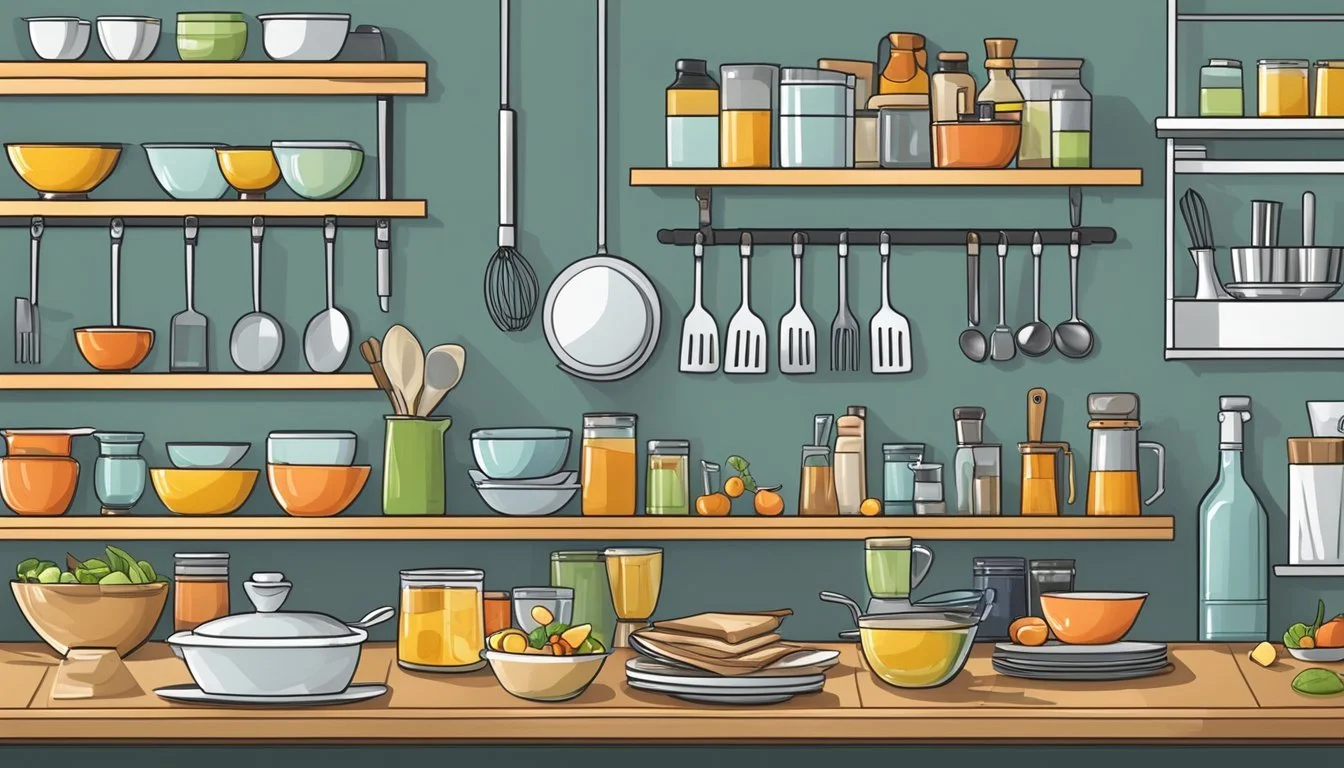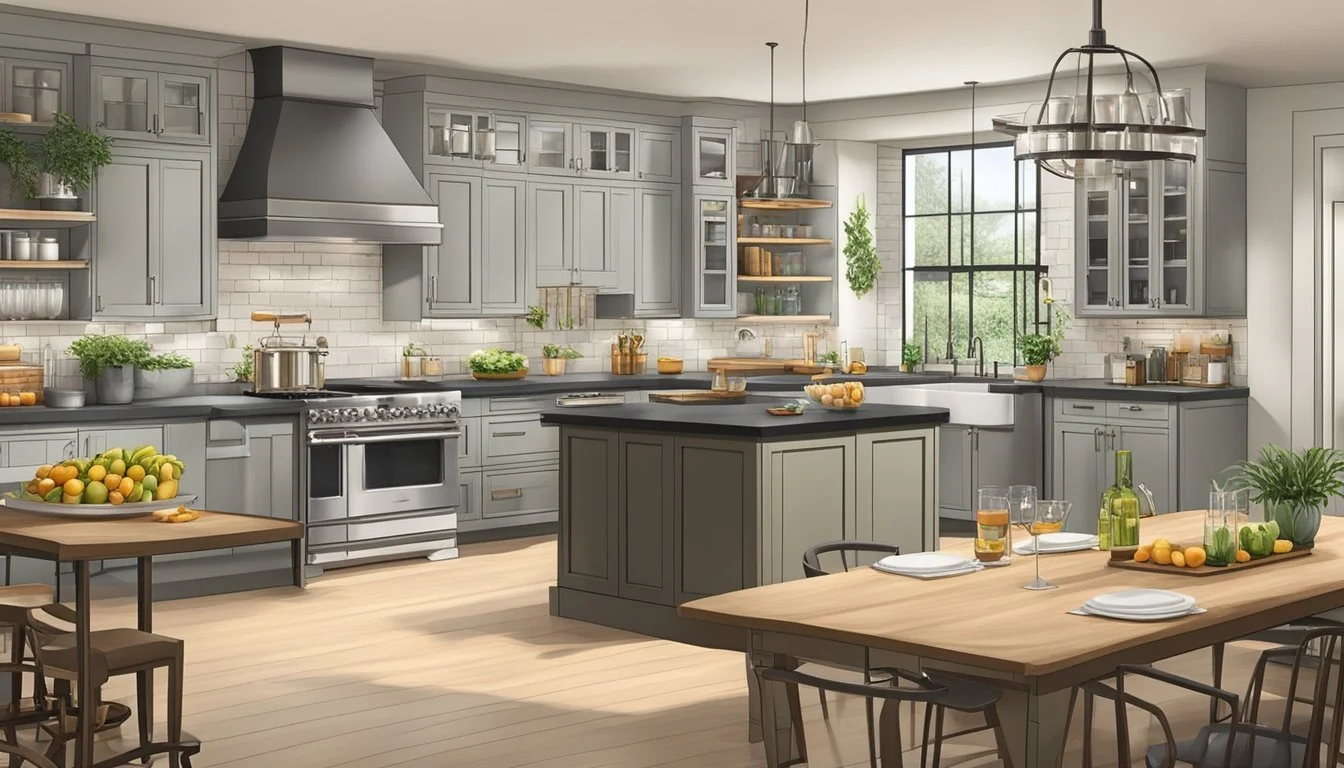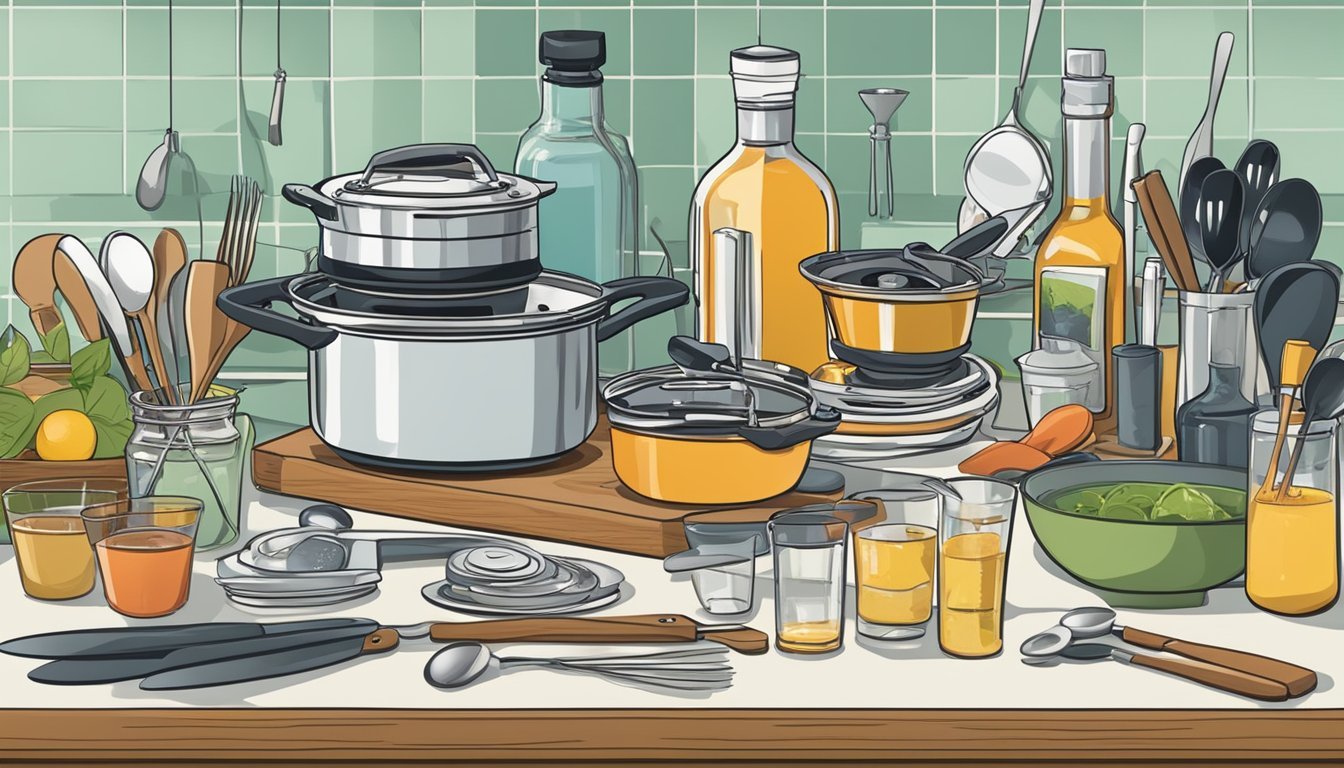How to Organize Your Kitchen for a Dinner Party with a Mixologist
Efficient Space Management Tips
Organizing a kitchen for a dinner (What wine goes well with dinner?) party where a mixologist is part of the entertainment can transform an ordinary gathering into a memorable experience. Ensuring that the kitchen space is efficiently arranged allows the mixologist to craft cocktails with ease while guests enjoy the thrill of watching their drinks being made. A well-organized kitchen also facilitates smooth transitions between courses, keeping the focus on the flavors and the company.
For the host, the key to a successful party lies in meticulous preparation, which involves thoughtful organization of kitchen tools, ingredients, and serving ware. The placement of ingredients and tools should be strategic, allowing for seamless movement and accessibility. This includes designating areas for prepping, mixing drinks, and serving food, each with necessary supplies at arm's reach.
In anticipation of the event, decluttering the kitchen counters and storage spaces is essential; this not only creates a clean aesthetic but also minimizes distractions and obstructions. An organized environment fosters an atmosphere conducive to socializing and enjoyment, enabling the hosts and their guests to revel in the culinary and mixology arts that highlight the evening.
Planning the Kitchen Layout
Effective kitchen layout planning ensures every inch serves a purpose, especially when preparing for a dinner party with a mixologist. Strategic placement of utensils, glasses, and ingredients can transform a kitchen into a functional space for cooking and cocktail crafting.
Maximizing Countertop Space
Ensuring ample countertop space is crucial for a seamless dinner party experience. The countertop should be clear of unnecessary items, with only essential appliances and tools within reach. Assigning a section of the kitchen island or countertop as a dedicated mixing station allows the mixologist to have a specialized workspace.
Priority Placement: Frequently used items like cutting boards and mixing tools.
Temporary Storage: Utilize rolling carts beneath the island for extra supplies.
Optimizing Cabinet Organization
Cabinets play a pivotal role in kitchen organization. Upper cabinetry ought to store glassware and crockery, positioning them strategically for easy access. Implementing cabinet door racks can provide additional space for storing smaller items, keeping them out of sight, yet accessible.
Transparent Organizers: See-through bins for quick identification of items in the cabinets.
Consistency is Key: Group like-items together to maintain order.
Utilizing Drawers and Dividers
Drawer organizers and drawer dividers can drastically increase the efficiency of a kitchen. Implementing these tools helps in categorizing utensils, which is beneficial when both cooking and mixing drinks. Allocate a drawer near the prep area specifically for mixology tools to keep them segregated from culinary utensils.
Adjusted Compartments: Customize dividers to fit tools of varying sizes.
Label Use: Label each drawer to remind guests and helpers of their contents.
Strategic Shelving Options
Shelving solutions such as open shelving and floating shelves provide easily accessible storage without the heaviness of additional cabinetry. Shelves should hold ingredients and equipment that are appealing to display and often used, contributing both aesthetically and functionally to the party atmosphere.
Height Advantage: Place lesser-used items on higher shelves.
Showcase Station: Reserve a lower open shelving area for an attractive arrangement of spirits and mixers.
Selecting Cookware and Utensils
When hosting a dinner party featuring a mixologist, having your kitchen organized with the appropriate cookware and utensils is crucial for a seamless experience. It enables the cook and mixologist to work efficiently, reduces clutter, and contributes to the event's success.
Keeping Cooking Utensils Accessible
For cooking utensils like spatulas, wooden spoons, and tongs:
Store in a countertop crock: This ensures easy access to frequently used utensils.
Drawer organizers: Use them to separate utensils into categories, allowing quick retrieval.
Organizing Pots, Pans, and Lids
To manage pots and pans:
Pot rack: Hang pots and pans on a pot rack to save cabinet space and keep them within reach.
Nesting with separators: Stack similar-sized pots and pans together with cloth separators to prevent scratching.
For pot lids:
Mounted lid organizers: Install inside cabinet doors to store lids, making them easy to grab without cluttering the space.
Managing Knives and Cutting Tools
Knives and cutting tools require care:
Magnetic strip: Mount a magnetic strip on the wall to hold knives, keeping them visible and out of reach of children.
Designated slots in a knife block: Protect blades and fingers by storing knives in a block.
Drawer dividers: Organize smaller cutting tools such as peelers in a separate section of a utensil drawer.
Dedicated area for cutting boards: Store cutting boards vertically in a rack close to the preparation area for easy access.
Storing Ingredients and Pantry Items
For a successful dinner party with a mixologist, having an organized kitchen with well-stored ingredients and pantry items is crucial. This enables efficient preparation and ensures that everything required for cooking and cocktail crafting is readily accessible.
Systematizing the Pantry
In the kitchen pantry, group related items together to maintain order. Canned foods, often used in various recipes, should be arranged on an accessible shelf. All cans should be faced forward with labels visible, ensuring quick identification. Glass jars often contain pickles or preserves that might accompany a dish or be used in a cocktail. These should be grouped together and, if possible, placed on a shelf at eye level for easy reach.
Organizing Spices and Oils
The spice drawer should be organized alphabetically or by frequency of use, whichever suits the host best. Essentials like salt, pepper, and often-used spices should be front and center. For oils, including olive oil, designate a spot near the cooking area. Ensure that these oils are kept in sealed containers to avoid spills and preserve freshness.
Keeping Dry Goods and Bulk Items Tidy
Dry goods such as sugar, flour, and nuts should be stored in clear, labeled glass storage containers. This not only keeps the contents visible but also helps to maintain their freshness. Bulk items, especially if bought for the occasion, may be stored in larger bins or baskets below the main shelving area to keep the pantry floor tidy and prevent heavy lifting above waist level.
Efficient Food Container Management
Lastly, food containers play a pivotal role in pantry organization. Items like pre-made mixes or prepped ingredients for the dinner party should be placed in airtight Tupperware or similar storage containers to maintain their quality. Transparent containers are preferable, as they allow one to quickly see their contents. Containers should stack easily to maximize space, with the most frequently used items placed in front for accessibility.
Refrigerator and Freezer Organization
When organizing for a dinner party with a mixologist, the primary goal is to ensure ingredients are both easily accessible and optimally stored to maintain freshness. An organized refrigerator promotes efficient workflow, while a well-arranged freezer ensures that space is maximized for items like ice and frozen garnishes.
Arranging the Refrigerator for Easy Access
One must strategically place items in the refrigerator to balance the need for food safety with the convenience of reaching for high-use ingredients.
Fresh Produce: Vegetables and fruits should be stored in separate humidity-controlled drawers. This segregation not only preserves their freshness but also prevents flavors from mingling.
Meat: Raw meats need to be placed on the lowest shelf to prevent any cross-contamination. If there’s a drawer specifically designed for meats, use it to further isolate them from other foods.
Cheese: In the case of both hard and soft cheeses, wrapping each in parchment paper before storing in a designated area or bin can help maintain their quality while making them easy to identify and retrieve.
Butter and Condiments: These can be stored on the door shelves; however, if the mixologist requires frequent use of certain condiments, position them in an area that’s promptly reachable, possibly in the upper shelves.
Table1: Suggested Refrigerator Layout
Shelf Recommended Items Top Drinks, ready-to-eat foods Middle Dairy, leftovers, prepped items Lower Raw meats, large bottles Drawers Fruits in one, vegetables in another Door Butter, condiments, juices
Maximizing Freezer Storage
The freezer should be used to extend the life of essentials and store mixologist needs like ice and frozen ingredients in a methodical way that conserves space.
Ice: Given that ice is essential for a mixologist, allot a large, accessible portion of the freezer for ice trays or bags. Ensure that the ice is away from strong-smelling foods to prevent taste transfer.
Frozen Garnishes: For frozen fruit garnishes or herbs, use labeled, airtight bags or containers stacked neatly. This prevents freezer burn and avoids searching during the event.
Meat: If additional meats are to be stored for the dinner party, vacuum sealing can dramatically increase storage space while offering better preservation.
Table2: Suggested Freezer Organization
Area Recommended Storage Top Shelf Ice and frequently used items Middle Shelf Frozen garnishes and herbs Bottom Shelf Bulk items, meats Door Small containers, additional ice packs
By following these guidelines, one can ensure that the refrigerator and freezer are ready to support a successful dinner party, allowing the mixologist and cook to access everything they require without unnecessary interruption.
Design and Decor Enhancements
When organizing your kitchen for a dinner party with a mixologist, consider how design and decor can enhance the atmosphere. Thoughtful implementation of color, decorative elements, and strategic use of wall space can transform a functional space into a festive and inviting area.
Implementing Color and Display Elements
Effectively using color can set the mood for your dinner party. Opting for a white base on table settings allows for colorful accents to stand out. Incorporate vibrant vases or picture frames that complement the color scheme of your party's theme. A mixologist station adorned with colorful but classy glassware adds both function and visual appeal.
Adding Plants and Greenery for a Lively Ambiance
Plants can breathe life into any setting. Place plants in decorative pots that match your color palette to maintain cohesion. Arrange small greenery on shelves and counters. Using DIY shelving to display plants not only maximizes wall space but also introduces a refreshing and lively ambiance perfect for social gatherings.
Utilizing Wall Space and Decorative Shelving
Wall space in a kitchen is often underutilized. Installing decorative shelving can serve as both a functional and an aesthetic feature. Display mixology books, unique bottles, or small decor items that speak to the craft of cocktail-making. This not only adds charm but also makes for great conversation starters.
Functional Extras and Innovations
To maximize kitchen organization for a dinner party involving a mixologist, one should consider incorporating functional extras and innovations that enhance storage and accessibility.
Exploring Extra Storage Options
For gatherings that require additional kitchenware and ingredients, extra storage is essential. Utilizing vertical space with shelf risers can double the storage capability of cabinets and counter spaces, making them ideal for stashing glassware and mixology tools. Clear bins can be added to these areas, providing visibility and ensuring items are easy to locate during the party.
Incorporating Divider and Basket Solutions
Dividers and baskets are invaluable for maintaining order within drawers and cabinets. Cabinet dividers can be installed to create dedicated compartments for utensils, while baskets can sort items based on their frequency of use or purpose. This helps the mixologist to quickly find their tools and ingredients, keeping the workflow smooth and efficient.
Using Labeling for Efficiency and Aesthetics
Labeling is not only functional but can also contribute to the visual appeal of the kitchen. Using a label maker to label clear bins and baskets achieves a clean and professional look. This clarity is particularly advantageous in a party setting, as it allows for quick identification of items by the mixologist and assists in maintaining the organization after usage.
Preparing for the Mixologist
When hosting a dinner party featuring a mixologist, one must ensure the kitchen is equipped with a dedicated beverage station and furnished with essential tools and glassware. This setup will facilitate the creation of high-quality, aesthetically pleasing drinks that are a hallmark of professional mixology.
Setting Up a Beverage Station
A well-organized beverage station serves as the centerpiece for drink preparation. A spacious table or countertop should be designated for the mixologist, with clear access to a power outlet if electric appliances are needed. It is essential to position the beverage station away from the main food prep area to avoid congestion. Stock the station with:
Olive oil and nuts: These can be set out in elegant serving dishes for guests to enjoy with their drinks.
Clean, empty wine glasses: Required for those who may prefer vino over mixed drinks.
Adequate lighting: Ensures the mixologist can see the drinks they are preparing.
Garbage and recycling bins: Positioned nearby to dispose of things like lemon peels or empty bottles efficiently.
Stocking a Mixologist's Essential Tools and Glassware
Every mixologist needs a range of tools to create cocktails that are both delicious and visually impressive. Ina Garten, an authority on entertaining, would agree that equipping your mixologist with the right tools is crucial for a successful dinner party. The essentials include:
Cocktail Shaker: For cocktails that require agitation to mix flavors effectively.
Measuring Tools: Such as jiggers or measuring cups for precision and consistency in cocktail creation.
Mixing Spoons: With a spiral handle, designed to mix drinks evenly.
Strainer: To remove unwanted solids from the drink.
Muddler: To release the flavors of herbs or fruits in the drink.
Glassware is equally as important and should be chosen to match the types of drinks being served. Basic glassware includes:
Highball Glasses: For long drinks.
Coupe Glasses: For champagne or cocktails served without ice.
Old Fashioned Glasses: For 'on the rocks' drinks.
Martini Glasses: For classic martinis or other cocktails served up.
Maintaining Your Organized Kitchen
An organized kitchen is essential for seamless entertaining, especially when hosting a dinner party with a mixologist. Maintaining the system and cleanliness put in place is key to ensuring that each event runs smoothly and that everyday tasks are managed with ease.
Regular Decluttering and Reorganization
Regular decluttering helps prevent the buildup of unnecessary items that can crowd your kitchen space. A monthly review of kitchen inventory allows for timely removal or donation of unused cookbooks, excess utensils, or outdated spices.
Assess and purge duplicates or rarely used gadgets.
Revisit organizing zones to ensure they still make sense; adjust as needed.
A maintained system discourages clutter and promotes efficiency, aiding in quick setups for events or everyday cooking.
Everyday Kitchen Maintenance Tips
For day-to-day upkeep, one needs to establish straightforward and consistent cleaning habits. A clean kitchen is a functional kitchen, where one can find and use their tools and ingredients with ease.
Daily habits: Wipe counters after use, wash dishes immediately, and sweep floors.
Weekly tasks: Mop floors, clean appliances, and sanitize sinks.
Maintaining these everyday items and cleaning routines ensures that the kitchen is always guest-ready, creating a stress-free environment for both cooking and socializing.
Conclusion
A well-organized kitchen is the backbone of a successful dinner party, especially when a mixologist is part of the event. To maximize countertop space and enhance the cooking experience;
Clear Countertops: Guests should notice a tidy space where culinary and cocktail magic can happen. This involves removing non-essential items and designating zones for prepping, mixing drinks, and serving.
Zoning: Implement zones dedicated to mixing drinks, cooking, serving, and cleaning. This allows for a smoother workflow and supports the mixologist and chef in their respective tasks.
Readiness for Action:
Ensure all tools and ingredients are accessible, promoting an efficient cooking and mixing environment.
Streamlined Cleaning: Keep cleaning supplies at the ready for any spills or quick tidy-ups, maintaining a clean space throughout the evening.
Self-Serve Stations:
Set up a self-serve area for guests to customize drinks to their liking, minimizing the need for constant mixologist interaction and allowing them to embrace the experience.
Remember, the key is in preparation and organization. A well-planned kitchen setup not only makes the role of the mixologist and host more manageable but also significantly enhances the overall enjoyment of the event for both the guests and the hosts.







